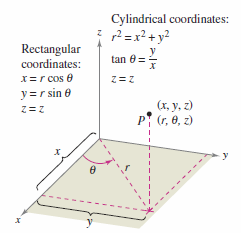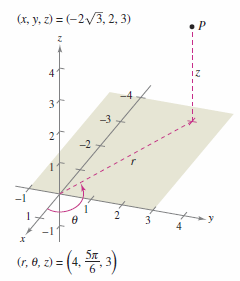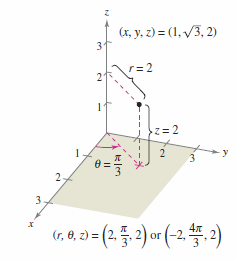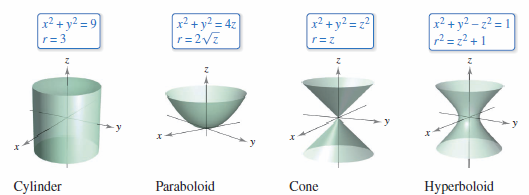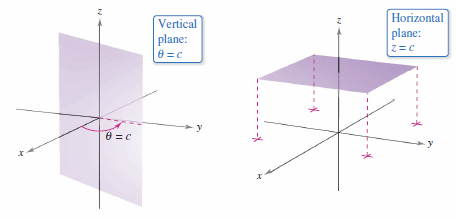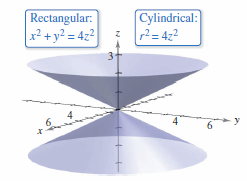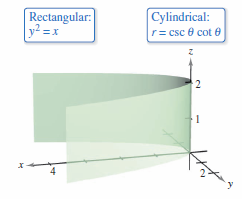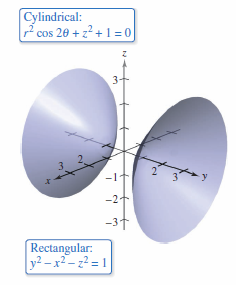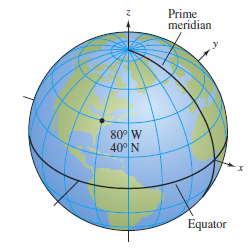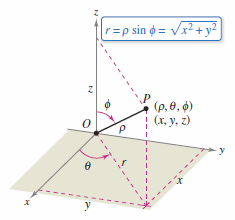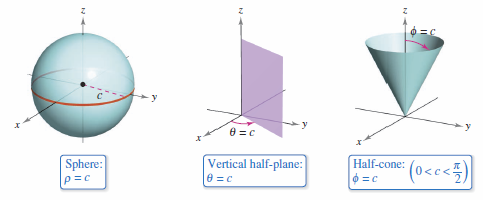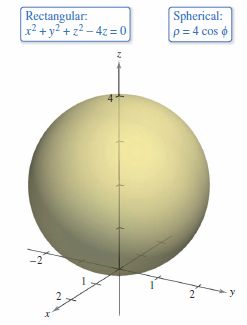Calculus III 11.07 Cylindrical and Spherical Coordinates
| Previous | Calculus III 11.06 Surfaces in Three Dimensions |
| Next | Calculus III 12 Vector-Valued Functions |
Contents
- 1 Calculus III 11.7 Cylindrical and Spherical Coordinates
- 1.1 Cylindrical Coordinates
- 1.1.1 Definition 11.7.1 The Cylindrical Coordinate System
- 1.1.2 Example 11.7.1 Cylindrical-to-Cartesian Point Conversion
- 1.1.3 Example 11.7.2 Cartesian-to-Cylindrical Point Conversion
- 1.1.4 Example 11.7.3 Cartesian-to-Cylindrical Equation Conversion
- 1.1.5 Example 11.7.4 Cylindrical-to-Cartesian Equation Conversion
- 1.2 Spherical Coordinates
- 1.1 Cylindrical Coordinates
- 2 Internal Links
Calculus III 11.7 Cylindrical and Spherical Coordinates
- Use cylindrical coordinates to represent surfaces in three dimensions.
- Use spherical coordinates to represent surfaces in three dimensions.
Cylindrical Coordinates
|
|
The cylindrical coordinate system extends polar coordinates from a flat plane to three dimensions. Definition 11.7.1 The Cylindrical Coordinate SystemIn a cylindrical coordinate system, a point \(P\) in three dimensions is represented by an ordered triple \((r, \theta,z)\).
To convert from cartesian to cylindrical coordinates (or vice versa), use the conversion guidelines for polar coordinates listed below and illustrated in Figure 11.7.1.
The point (0,0,0) is called the pole. Moreover, because the representation of a point in the polar coordinate system is not unique, it follows that the representation in the cylindrical coordinate system is also not unique. |
Example 11.7.1 Cylindrical-to-Cartesian Point Conversion
|
|
Convert the point \((r,\theta,z)=(4,5\pi/6,3)\) to cartesian coordinates.
In cartesian coordinates the point is \(x,y,z)=(-2\sqrt{3},2,3)\), as shown in Figure 11.7.2. |
Example 11.7.2 Cartesian-to-Cylindrical Point Conversion
|
|
Convert the point \((x,y,z)=(1,\sqrt{3},2)\) to cylindrical coordinates.
There are two choices fro \(r\) and infinite choices for \(\theta \). Two convenient choices are shown in Figure 11.7.3.
and
|
Cylindrical coordinates are especially convenient for representing cylindrical surfaces and rotated surfaces with the \(z\)-axis as the symmetric axis, as shown in Figure 11.7.4.
Vertical planes containing the \(z\)-axis and horizontal planes also have simple cylindrical coordinate equations, as shown in Figure 11.70.
Example 11.7.3 Cartesian-to-Cylindrical Equation Conversion
|
|
Find an equation in cylindrical coordinates for the surface represented by each cartesian equation.
is an elliptic cone with its axis along the \(z\)-axis, as shown in Figure 11.7.6. Replacing \(x^{2}+y^{2}\) with \(r^{2}\), the equation in cylindrical coordinates is
b. The graph for the surface
is a parabolic cylinder with rulings parallel to the \(z\)-axis, as shown in Figure 11.7.7. To obtain the equation in cylindrical coordinates, replace \(y^{2}\) with \(r^{2} \sin^{2} \theta \) and \(x\) with \(r \cos \theta \), as shown.
Note that this equation includes a point for which \(r=0\), so nothing was lost by dividing each side by the factor \(r\). |
Example 11.7.4 Cylindrical-to-Cartesian Equation Conversion
|
|
Find an equation in cartesian coordinates for the surface represented by the cylindrical equation
Solution Converting from cylindrical coordinates to cartesian coordinates is less straightforward than converting from cartesian coordinates to cylindrical coordinates, as shown below.
This is a hyperboloid of two sheets whose axis lies along the \(y\)-axis, as shown in Figure 11.7.8. |
Spherical Coordinates
|
|
In the spherical coordinate system, each point is represented by an ordered triple: the first coordinate is a distance, and the second and third coordinates are angles. This system is similar to the latitude-longitude system used to identify points on
Earth's surface. For example, on Earth the point whose latitude is 40° North (from the equator) and whose longitude is 80& #176; West (from the prime meridian) is shown in Figure 11.7.10. Assuming that Earth is spherical with a 4000 mile radius, this point is label as shown in Figure 11.7.10 |
Definition 11.7.2 The Spherical Coordinate System
|
|
In a spherical coordinate system, a point \(P\) in three dimensions is represented by an ordered triple \(( \rho,\theta,\phi)\), where \(\rho\) is the lowercase Greek letter rho and \(\phi\) is the lowercase Greek letter phi.
|
The formulas to convert coordinates from cartesian to spherical are below:
Spherical to Cartesian:
- \(x=\rho \sin \phi \cos \theta\), \(y=\rho \sin \phi \sin \theta \), \(z = \rho \cos \phi \)
Cartesian to Spherical:
- $$\rho^{2}=x^{2}+y^{2}+z^{2}, \:\:\:\: \tan \theta=\frac{y}{x} ,\:\:\:\: \phi= \arccos \left ( \frac{z}{\sqrt{x^{2}+y^{2}+z^{2}}} \right ) $$
The formulas to convert coordinates from cylindrical to spherical are below:
Spherical to Cylindrical \((r \geqslant 0)\):
- \(r^{2}= \rho^{2} \sin^{2} \phi, \:\:\:\: \theta = \theta, \:\:\:\: z=\rho \cos \phi \)
Cylindrical to Spherical \((r \geqslant 0)\):
- $$ \rho = \sqrt{r^{2}+z^{2}}, \:\:\:\: \theta = \theta, \:\:\:\: \phi= \arccos \left ( \frac{z}{\sqrt{r^{2}+z^{2}}} \right )$$
The spherical coordinate system is useful primarily for solids and surfaces in three dimensions that have symmetry at a point or center. Three surfaces with simple spherical equations are shown in Figure 11.7.12.
Example 11.7.5 Cartesian-to-Spherical Equation Conversion
|
|
Find an equation in spherical coordinates for the surface represented by each cartesian equation.
This produces \(\phi\) with two possible values
The equation \(\phi = \pi /4 \) represents the upper half-cone, and the equation \(\phi = 3\pi /4 \) represents the lower half-cone.
Temporarily discarding the possibility that \(\rho=0\) produces the spherical equation
Note that the solution set for this equation includes a point for which \(\rho=0\), so nothing is lost by discarding the factor \(\rho\). The sphere represented by the equation \(\rho = 4 \cos \phi \) is shown in Figure 11.7.13. |
Internal Links
Parent Article: Calculus III 11 Vectors and Spacial Geometry
